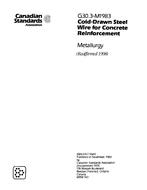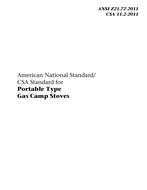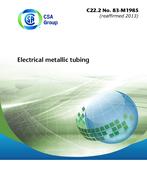Preface
This is the fourth edition of CSA B140.0, Oil-burning equipment: General requirements . It supersedes the previous editions, published in 2003, 1987, and 1972. The major changes to this edition include the following:
a) added a clause specifying Standard requirements applicability (Clause 1.2);
b) replaced ASTM B154 with ANSI/CAN/UL/ULC 125 as a method of stress-cracking test (Clause 5.2.11);
c) revised values in this Standard for precision and consistency;
d) added a requirement that the combustion be stable and complete under abnormal voltages, abnormal oil feed pressures and abnormal drafts (Clause 8.2.1);
e) added a requirement that a heating appliance equipment be subjected to a simulated life test without evidence of failure of the combustion chamber where the design of the through-the-wall venting system is unproven;
f) deleted clauses specifying safety limit controls used with a warm air furnace, a hot water heating boiler, a hot water heater, and a steam heating boiler because specific requirements are given in individual appliance Standards;
g) modified performance test procedures to require the time for the burner to be shut off by the blocked vent system not to exceed 5 min (Clause 9.5.4);
h) added a requirement for instruction specifications for draft regulators (Clause 11.1.3);
i) added a note on permission of using galvanized or aluminized steel in the construction of draft regulators (Clause 11.2.4);
j) modified details for heat reclaimer marking requirements and instructions (Clauses 12.3 and 12.4);
k) clarified procedure for CO2 and O2 measurement calculations (Clause 13.5.2);
l) modified instructions on traverse air velocity pressure measurement (Clause 13.6.4);
m) replaced reference to a base temperature of 25 °C with a reference to ambient temperature with a specified range between 18 and 30 °C (Clause 14.5);
n) modified temperature rise and ambient temperature requirements and tabulated maximum allowable temperatures for general construction materials per changes to base temperature (Clause 14.5 and Table 3);
o) clarified thermocouple twisting and securing methods, as well as wire gauges for temperature measurement details (Clause 14.6);
p) clarified requirements related to condensing venting systems (Clauses 15.2.4 and 18.1);
q) modified smoke test pump method description to reference the use of an applicable field smoke test pump (Clause 16.1);
r) clarified that the smoke density test measurement be taken at the operating fuel input ;
s) added a requirement for carbon monoxide in unburned fuel gases not to exceed 400 ppm air-free at any time of testing (Clause 18.2.2), and removed all clauses contradicting this requirement;
t) deleted requirements specifying casing (jacket) loss for units intended to be installed outdoors or in an unheated space because they contradicted other Standards in the CSA B140 series;
u) removed a requirement stating that venting systems need to be supplied by the appliance manufacturer (Clause 20.2);
v) modified the description of a through-the-wall venting system (Clause 20.2);
w) modified the requirement for means preventing the operation of the burner in the event of a venting system blockage or a combustion air system blockage to include a mechanical device (such as a pressure switch or sail switch), and to prohibit use of burner flame detection (Clauses 20.3.7 and 21.3.7);
x) added tables of maximum allowable temperatures for
i) electrical wiring materials (Table 7); and
ii) electrical components and electrical insulations (Table 8);
y) added a requirement that in cases where the smoke density of the vented flue gas rises above Number 2 (except at start-up), the oil burner shuts down (Clause 20.11.2.1.2);
z) clarified that during steady-state operation of the oil-burning appliance, the vent is slowly blocked by 10% increments from the fully open position (Clause 20.11.2.2.1);
aa) limited the requirement that operation of the appliance and its venting system be initiated from a cold start over the range of flue-outlet pressures (Clause 21.5.2);
ab) clarified that the complete combustion air system (with the exception of standard combustion air connector pipe or duct) meet the requirements of the appliance manufacturer’s installation instructions, and not necessarily be manufactured by the furnace or boiler manufacturer (Clause 21.3.10);
ac) clarified that the requirement for flue-outlet pressure to be set as indicated in the normal combustion test in the CSA B140 series of Standards applies to appliances designed for operation with a draft regulator (Clause 21.4.1);
ad) clarified that during continuity condition operation of the appliance, the combustion air intake terminal be slowly blocked by 10% increments from the fully open position (Clause 21.5.1.1);
ae) removed allowance of 2% leakage of the products of combustion from the heat exchanger (Clause 22.1) and the venting system (Clause 22.2) when operated under positive internal pressure;
af) added a requirement that direct vent system leakage tests be performed with the flue terminal exit and the air intake opening being sealed (Clause 22.2); and
ag) added French translations of caution statements.
This Standard is considered suitable for use for conformity assessment within the stated scope of the Standard. This Standard was prepared by the Technical Committee on Oil-Burning Appliance Standards, under the jurisdiction of the Strategic Steering Committee on Fuels and Appliances, and has been formally approved by the Technical Committee. This Standard has been developed in compliance with Standards Council of Canada requirements for National Standards of Canada. It has been published as a National Standard of Canada by CSA Group.
Scope
1.1 Application This Standard provides minimum requirements for oil-burning equipment, including a) fuel oil filters; b) draft regulators; c) flue pipe mounted heat reclaimers; d) through-the-wall venting systems; e) systems that supply outside combustion air; and f) used-oil-burning equipment.
1.2 Intended use This Standard is to be used in conjunction with the other Standards in the CSA B140 series, as applicable, to form a complete Standard for a particular type of oil-burning appliance or equipment.
1.3 Correlation with the CSA B140 series of Standards Each of the other Standards in the CSA B140 series covers construction requirements, marking, instructions, and detailed testing procedures for a single classification or a closely related group of oil- burning equipment.
1.4 Units of measurement The values given in SI (metric) units are the units of record for the purpose of this Standard. The values given in parentheses are for information and comparison only.
1.5 Terminology In this Standard, “shall” is used to express a requirement, i.e., a provision that the user is obliged to satisfy in order to comply with the Standard; “should” is used to express a recommendation or that which is advised but not required; and “may” is used to express an option or that which is permissible within the limits of the Standard. Notes accompanying clauses do not include requirements or alternative requirements; the purpose of a note accompanying a clause is to separate from the text explanatory or informative material. Notes to tables and figures are considered part of the table or figure and may be written as requirements. Annexes are designated normative (mandatory) or informative (non-mandatory) to define their application.
Product Details
- Edition:
- 4th
- Published:
- 06/30/2022
- ISBN(s):
- 9781488318702
- Number of Pages:
- 123
- File Size:
- 1 file , 1.5 MB
- Product Code(s):
- 2426770, 2426770
- Note:
- This product is unavailable in Russia, Ukraine, Belarus


